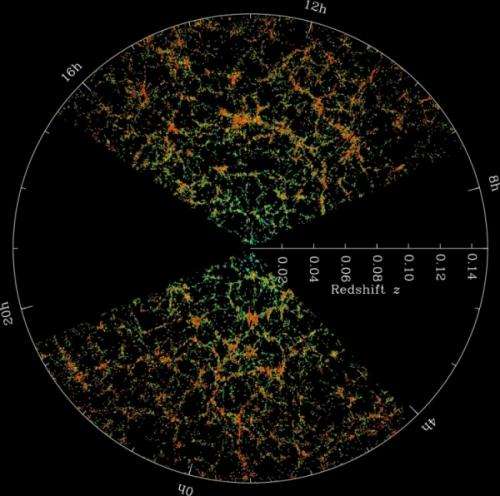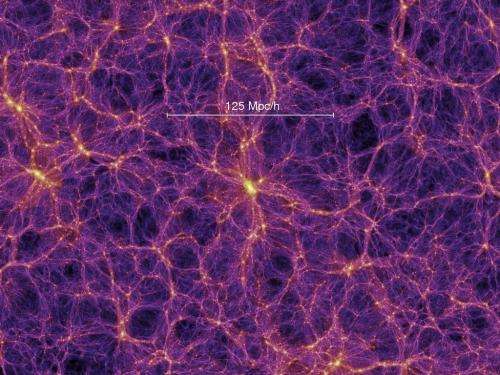Cosmologists weigh cosmic filaments and voids

(Phys.org) —Cosmologists have established that much of the stuff of the universe is made of dark matter, a mysterious, invisible substance that can't be directly detected but which exerts a gravitational pull on surrounding objects. Dark matter is thought to exist in a vast network of filaments throughout the universe, pulling luminous galaxies into an interconnected web of clusters, interspersed with seemingly empty voids.
Researchers at the University of Pennsylvania have measured the "weight" of these cosmic voids and filaments for the first time, showing the former are not as empty as they look.
The studies of voids and filaments are currently available on the ArXiv and were conducted by graduate student Joseph Clampitt and professor Bhuvnesh Jain of the Department of Physics and Astronomy in Penn's School of Arts & Sciences.
Gravitational lensing, the tiny distortions of distant galaxy images due to intervening matter, allows scientists to weigh galaxies by measuring how much their light bends. Voids, on the other hand, are enormous, seemingly empty spaces in the universe with scarcely any galaxies visible — an arrangement that makes measuring their contents through lensing more difficult.
While galaxies and filaments have more mass than the average regions of the universe, voids have less mass than average. This unbalanced distribution causes matter to rapidly move away from voids and towards the concentrations of mass along the cosmic filaments that lie between them.

"This means that voids act like objects with an effectively negative mass," Clampitt said, "such that even light rays bend away from them. They act roughly like concave lenses, the opposite of big galaxies, which act like convex lenses."
Clampitt and Jain detected the tiny distortions produced by voids on the images of nearly 40 million galaxies in the Sloan Digital Sky Survey. This breakthrough came just a few months after they, along with Masahiro Takada of Tokyo University's Institute for the Physics and Mathematics of the Universe, detected the lensing signal from the dark matter filaments that connect galaxies.
"The measurements came as a wonderful surprise," Jain said. "Theoretical studies had predicted that we'd have to wait for much bigger surveys well into the future to detect void lensing. Joseph's ingenious analysis techniques extracted a subtle signal no one had seen before."
The team's trick to wringing these measurements out of existing data was a new way of processing the images of galaxies. The images from the Sloan Digital Sky Survey contain distortions from the atmosphere and telescope imperfections that are larger than the cosmological signal the researchers aimed to detect. Exploiting symmetries of the lensing effect, they were able suppress these terrestrial distortions so the ones stemming from the cosmic voids and filaments were clearer.
Their results show that voids are not as empty as they appear. Dark matter and other dim structures permeate all the way to the center of the voids.
"Although the density of this matter is far less than average," Clampitt said, "it is somewhat surprising that the voids are not as empty as the galaxy distribution suggests."
"The density at the center of a typical void," Jain said, "is about half the mean density in the universe, but that still leaves the voids with an enormous deficit in mass, about a thousand trillion times the mass of the sun."
Provided by University of Pennsylvania



















